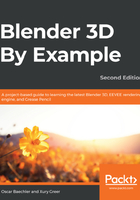
Simple materials and the nodal workflow
The kitchen has several objects whose materials are simple to set up and will serve as a good introduction to the basics of PBR. Eevee's real-time rendering is based around controlling a limited set of variables that have the potential to replicate all of the physically possible materials in the entire world. Take any dirt, meteor, banana, or liquid in the universe, and you can map its properties from a value of 0 (0%) to a value of 1 (100%):
- Black to white colors (distributed over Red, Green, and Blue (RGB) pixels)
- Transparent to opaque
- Rough to smooth
- Dielectric to metallic
Nodes are a way to map those values. A value of 0 Roughness means not rough at all. A value of 1 Roughness means very rough. A value of 0 Transparency is completely opaque. A value of 1 Transparency is completely transparent. If you took a photograph, it has pixels, which have values ranging from black to white. A node could simply use the input (a picture) to drive an output (such as transparency), and the light pixels will be transparent, black pixels opaque, and grayscale pixels somewhere in between.
The coordinates for your materials can also be represented in this way, usually through a vector input. The bounding box for an object could map the bottom of the object (0, 0%, black) to top (1, 100%, white), and the same for its transition from left to right or front to back, like colored syrup at the top of a snow cone, dispersing down. Instead of a pixel's location in the bounding box, you could instead map the direction each face's normal is pointing, like cliffs where snow only lands and sticks to the faces pointed upward. The Fresnel effect causes many materials to change properties depending on whether a plane faces you (black) or is turned away from you, eventually being on the hidden backside (white). Distant lake water is a mirror, reflecting the sunset (fresnel 1, white), but when you look down it's instead transparent, where a carp is swimming around your ankle (fresnel 0, black).
Nodes are a form of visual programming and a little scary to newcomers. Although it sounds like a lot of math and logic, the payout is tremendous, and the concepts extend into other areas of Blender as well. When nodes become overwhelming, try to reconstruct the node trees of others verbatim, and the results often reveal how nodes work. Use existing node materials, and see what happens when you break or modify the node tree. Test out your hunches, and don't be afraid to experiment. Let's have a look at how to control these properties with shader nodes.